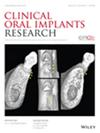种植体支持的固定义齿边缘错位对种植体周围骨水平的影响:回顾性定量分析
IF 5.3
1区 医学
Q1 DENTISTRY, ORAL SURGERY & MEDICINE
引用次数: 0
摘要
目的评价种植体支撑假体(ISP)的边缘配合度对种植体周围骨水平的影响。此外,该研究的目的是确定一个临床上相关的阈值,当ISP存在放射学垂直不匹配间隙时,并确定与骨水平变化相关的潜在危险因素。方法本研究纳入了接受isp牙齿替代治疗的受试者。装填10年后,采用标准化的口内根尖周x线片评估植入体肩关节与冠状骨(DIB)最冠状点之间的x线距离。ISP边际间隙分为无间隙和间隙,垂直尺寸分为0 mm、0 ~ 0.1 mm和≥0.1 mm。采用多变量线性混合效应模型控制潜在混杂因素。结果共分析301例患者和505颗种植体,随访10.6±0.7年。无间隙isp的DIB值(3.22±0.8 mm)显著低于有间隙isp的DIB值(3.43±0.6 mm, p = 0.001)。与>; 0和<; 0.1 mm的间隙(3.36±0.5 mm, p = 0.001)或无间隙(3.22±0.7 mm, p = 0.001)相比,间隙≥0.1 mm的DIB值(3.45±0.7 mm, p = 0.001)有统计学意义显著升高。垂直峰隙每增加0.1 mm, DIB值显著增加(0.08 mm, p = 0.03)。最后,吸烟和牙周炎史是DIB增加的独立危险因素。结论ISP的轻微错位影响种植体周围的骨稳定性,间隙≥0.1 mm与较高的DIB相关。吸烟和牙周炎是DIB增加的独立危险因素。本文章由计算机程序翻译,如有差异,请以英文原文为准。
Impact of Marginal Misfit in Implant‐Supported Fixed Dental Prostheses on Peri‐Implant Bone Levels: A Retrospective Quantitative Analysis
ObjectivesTo evaluate the impact of the marginal fit of implant‐supported prostheses (ISP) on peri‐implant bone levels. Additionally, the study aimed to determine a clinically relevant threshold for the radiographic vertical misfit gap at the ISP, when present, and to identify potential risk factors associated with changes in bone levels.MethodsThis study involved subjects who received ISPs for tooth replacement therapy. Standardized intraoral periapical radiographs were taken 10 years after loading to assess the radiographic distance between the implant shoulder and the most coronal point of crestal bone (DIB). ISP marginal gaps were categorized as no gap or gap, with vertical dimensions categorized as 0 mm, > 0‐ < 0.1 mm, and ≥ 0.1 mm. A multivariable linear mixed‐effect model was applied to control for potential confounders.ResultsA total of 301 patients and 505 implants with a 10.6 ± 0.7 years follow‐up were analyzed. ISPs without gaps exhibited statistically significantly lower DIB values (3.22 ± 0.8 mm) than those with gaps (3.43 ± 0.6 mm; p = 0.001). Gaps ≥ 0.1 mm were associated with statistically significantly higher DIB values (3.45 ± 0.7 mm; p = 0.001) compared with gaps between > 0 and < 0.1 mm (3.36 ± 0.5 mm; p = 0.001), or no gaps (3.22 ± 0.7 mm; p = 0.001). Each increment of 0.1 mm in the vertical crestal gap corresponded to a significant increase in DIB values (0.08 mm; p = 0.03). Finally, smoking and a history of periodontitis were independent risk factors for increased DIB.ConclusionsMarginal misfit of ISP affects peri‐implant bone stability, with gaps ≥ 0.1 mm linked to higher DIB. Smoking and periodontitis are independent risk factors for increased DIB.
求助全文
通过发布文献求助,成功后即可免费获取论文全文。
去求助
来源期刊

Clinical Oral Implants Research
医学-工程:生物医学
CiteScore
7.70
自引率
11.60%
发文量
149
审稿时长
3 months
期刊介绍:
Clinical Oral Implants Research conveys scientific progress in the field of implant dentistry and its related areas to clinicians, teachers and researchers concerned with the application of this information for the benefit of patients in need of oral implants. The journal addresses itself to clinicians, general practitioners, periodontists, oral and maxillofacial surgeons and prosthodontists, as well as to teachers, academicians and scholars involved in the education of professionals and in the scientific promotion of the field of implant dentistry.
 求助内容:
求助内容: 应助结果提醒方式:
应助结果提醒方式:


